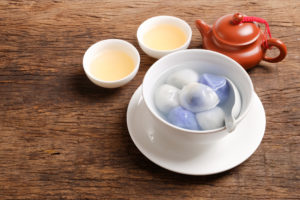
Mention the winter solstice and you may conjure up mental images of Stonehenge, modern pagan rituals, or an early evening setting sun dipping below snow-blanketed horizons. At the same time, winter solstice commemorations are common across many cultures around the globe. You’re probably familiar with European traditions such as the ancient Roman feast of Saturnalia and the Germanic Yule festivities, but societies in Asia, the Middle East, and Turtle Island have marked midwinter with their own holidays and celebrations.
China’s Dongzhi Festival: Darkness Behind, Light Ahead
“Dōngzhì” translates from Chinese as “the extreme of winter.” Usually observed around December 21 or 22, this holiday marks the winter solstice. GB Times journalist Linda Sigurðardóttir mentions in a December 2016 article that it’s the final festival of the Chinese lunar year and a turning point after which people look forward to longer days and more sunlight. Writer Wes Radez explains on his blog Chinese American Family that this holiday can also signify a harmonious balance of yin and yang energies, since yin is typically associated with darkness and cold while yang symbolizes light and warmth.
In her GB Times piece, Sigurðardóttir adds that the Dongzhi Festival originated in China around 2,000 years ago and was a major public holiday in which shops were closed and people did not go to work. Most who observe Dongzhi in modern times don’t get the day off, but they still celebrate with rituals and sacrifices honoring their ancestors as well as family meals that include rice dumplings in ginger broth and lamb dumplings. Similar winter solstice festivals are held in Taiwanese, Japanese, Korean, Vietnamese, and Malaysian communities throughout the world.
Soyal and Shalako: Bringing Back the Sun
Among Pueblo Indigenous groups in the southwestern United States, the winter solstice is an important holiday. Around December 21, the Hopi celebrate Soyal and the Zuni mark it with their Shalako dances. History Channel writer Sarah Pruitt reveals that both celebrations commemorate the rebirth or return of the sun.
Each community’s Pekwin fasts, prays, and watches the rising and setting of the sun for several days to determine exactly when the solstice will take place. Once this Sun Priest announces the solstice sun’s setting, an overnight ceremony with fires, dances, and gifting begins. Homes, animals, and plants are blessed with prayer sticks that were made prior to the start of the holiday. Kivas, or underground ceremonial rooms, are also reopened to welcome the return of protective spirit beings known as kachinas.
Shab-e Yalda: The Victory of Light
Welcoming the morning sun after the longest night of the year is the purpose of Yalda, a Persian holiday still celebrated by modern Iranians. Society and culture website Real Iran clarifies that its commemoration began when most ancient Persians followed Zoroastrianism, well before Islam took root in the region during the seventh century C.E. Yalda celebrants stay up and keep watch during the long and dark night, which was originally believed to be an unlucky time during which evil forces were very active. Spending the night with their families, Iranians feast on remaining summer fruits, enjoy each other’s company, and read poetry until the dawn breaks and they rejoice at the new day.
After the Dark Night, the Dawn Will Come
Since the beginning of time, humans have looked to the skies to chart the seasons, predict future events, and make sense of the world. Culture and religion are usually closely tied together, but holidays celebrated on the winter solstice are common in several societies. Many of these focus on seasonal endings or the return of longer days and plentiful sunlight. Even in our contemporary world, the human tendency of holding hope within dark times remains.

